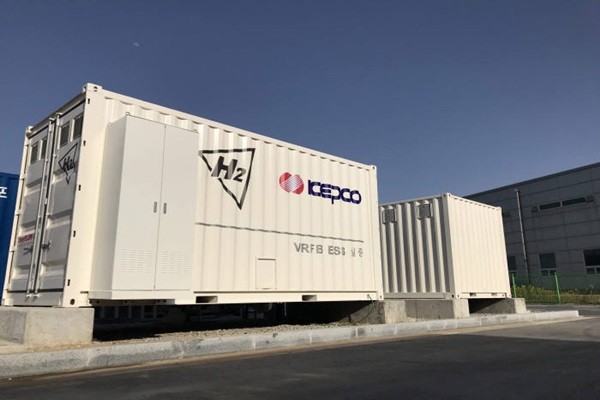‘VRFB (Vanadium Redox Flow Battery)’, which has no risk of fire, is expected to be used within solar ESS (Energy Storage System) market shortly.
H2, a South Korean flow battery business, stated that it is planning to release its new product called ‘EnerFLOW 430’, which is optimized for solar ESS businesses, after dealing with revised REC (Renewable Energy Certificate) regulation on renewable energy-based flow battery ESS.
Ministry of Trade, Industry and Energy (MOTIE) passed a regulatory sandbox that politically recommends flow battery ESS to be added to facilities that are subjected to being issued REC weight in April. When revision of relevant regulations is completed sometime during the second half, a business can apply VRFB to solar ESS to enter REC sales market.
Redox flow battery has electrolytes flowing through the stack, which is responsible for battery output, and repeats charge and discharge by causing electrochemical reaction. Vanadium makes up most of electrolytes. Because redox battery has more than 20 years of lifespan and does not use volatile electrolyte, it has no risk of fire hazard. It has recently emerged as the next ESS battery as there have been many fire accidents involving lithium-ion battery-based ESS.

H2 is the first South Korean business to commercialize redox flow battery in 2013. It currently has its product installed at industrial complexes in Gongju, Sejong, Jinan, and Onsan and it also had an experience of installing MWh worth of batteries in South Korea in 2018.
EnerFLOW 430, which is expected to be released during the second half, is a solar ESS that integrates a flow battery, PCS (Power Conversion System), and BMS (Battery Management System) into a 20-feet container. Basic capacity of single container is between 300 and 385kWh and it is very easy to expand capacity to MWh. EnerFLOW430 can be linked to both AC grid and DC grid and it has high usability as it uses a universal inverter.
This product has almost zero chance of causing a fire accident as it uses water-type electrolytes. National Fire Protection Association and Occupational Safety and Health Administration categorized safety measure (0 to 4) of an active vanadium material as 0 for both explosiveness and chemical reactivity.
H2 recently installed 42kW/200kWh VRFB ESS at KEPCO’s Gochang Power Testing Center. This is the first time that a flow battery is installed at KEPCO’s facility. KEPCO (Korea Electric Power Corporation) is planning to carry out various tests to expand application of flow batteries into various areas.
“Due to high safety, we expect that VRFB will start to distinguish itself within solar energy market.” said CEO Han Shin of H2. “We are going to work with businesses that are planning to set up solar ESS and we are planning to supply EnerFLOW 430 starting from the second half.”
Staff Reporter Jung, Hyunjung | iam@etnews.com
www.english.etnews.com

